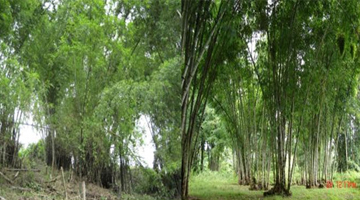 Not all bamboos are created equal.
Not all bamboos are created equal.
Although often used for making furniture, especially in the countryside, kawayan tinik (Bambusa blumeana Schultes f.) and giant bamboo (Dendrocalamus asper (Schultes f.) Backer ex Heyn) species, based on the findings of UPLB-CFNR researchers, are more suitable for crafting engineered bamboos.
Basically, these two species possess the desirable characteristics of poles for producing engineered bamboo ― large diameter, straight, with thick culm walls and high density, and defect-free. Poles from these species are also readily available.
Kawayan tinik is found in lowlands across the country. It grows erect in clumps and extends up to 15-25 m tall with an average culm diameter of 6-10 cm. Its large clumps and spiny branches at its basal portion are the distinguishing features of this bamboo species.
Giant bamboo, on the other hand, has a towering height of 32 m, with about 20 culms in a clump measuring 2-3 m in diameter. This bamboo is spineless with young culms covered with velvety hairs and thrives in areas with good drainage and high elevation.
Kawayan tinik is a good raw material for bamboo parquets and laminated products like tables, chairs, and doors. Other than producing plywood and tiles, giant bamboo is also used for construction, pulp, and papermaking.
Preferred for traditional and emerging applications, both species have been widely studied for their high commercial value.
